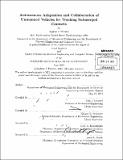Autonomous adaptation and collaboration of unmanned vehicles for tracking submerged contacts
Author(s)
Privette, Andrew Jamie
DownloadFull printable version (14.28Mb)
Other Contributors
Massachusetts Institute of Technology. Dept. of Electrical Engineering and Computer Science.
Advisor
John J. Leonard and Michael R. Benjamin.
Terms of use
Metadata
Show full item recordAbstract
Autonomous operations are vital to future naval operations. Unmanned systems, including autonomous underwater vehicles (AUVs) and autonomous surface vehicles (ASVs), are anticipated to play a key role for critical tasks such as mine countermeasures (MCM) and anti-submarine warfare (ASW). Addressing these issues with autonomous systems poses a host of difficult research challenges, including sensing, power, acoustic communications, navigation, and autonomous decision-making. This thesis addresses the issues of sensing and autonomy, studying the benefits of adaptive motion in overcoming partial observability of sensor observations. We focus on the challenge of target tracking with range-only measurements, relying on adaptive motion to localize and track maneuvering targets. Our primary contribution has been to develop new MOOS-IvP autonomy and state estimation modules to enable an autonomous surface vehicle to locate and track a submerged contact using range-only sensor information. These capabilities were initially tested in simulation for increasing levels of complexity of target motion, and subsequently evaluated in a field test with a Kingfisher ASV. Our results demonstrate the feasibility, in a controlled environment, to localize and track a maneuvering undersea target using range-only measurements.
Description
Thesis (Nav. E.)--Massachusetts Institute of Technology, Dept. of Mechanical Engineering; and, (S.M.)--Massachusetts Institute of Technology, Dept. of Electrical Engineering and Computer Science, 2012. Cataloged from PDF version of thesis. Includes bibliographical references (p. 103-106).
Date issued
2012Department
Massachusetts Institute of Technology. Department of Electrical Engineering and Computer Science; Massachusetts Institute of Technology. Department of Mechanical EngineeringPublisher
Massachusetts Institute of Technology
Keywords
Mechanical Engineering., Electrical Engineering and Computer Science.